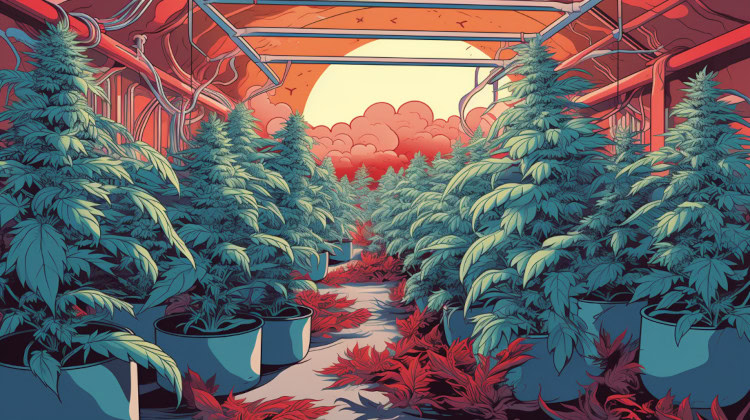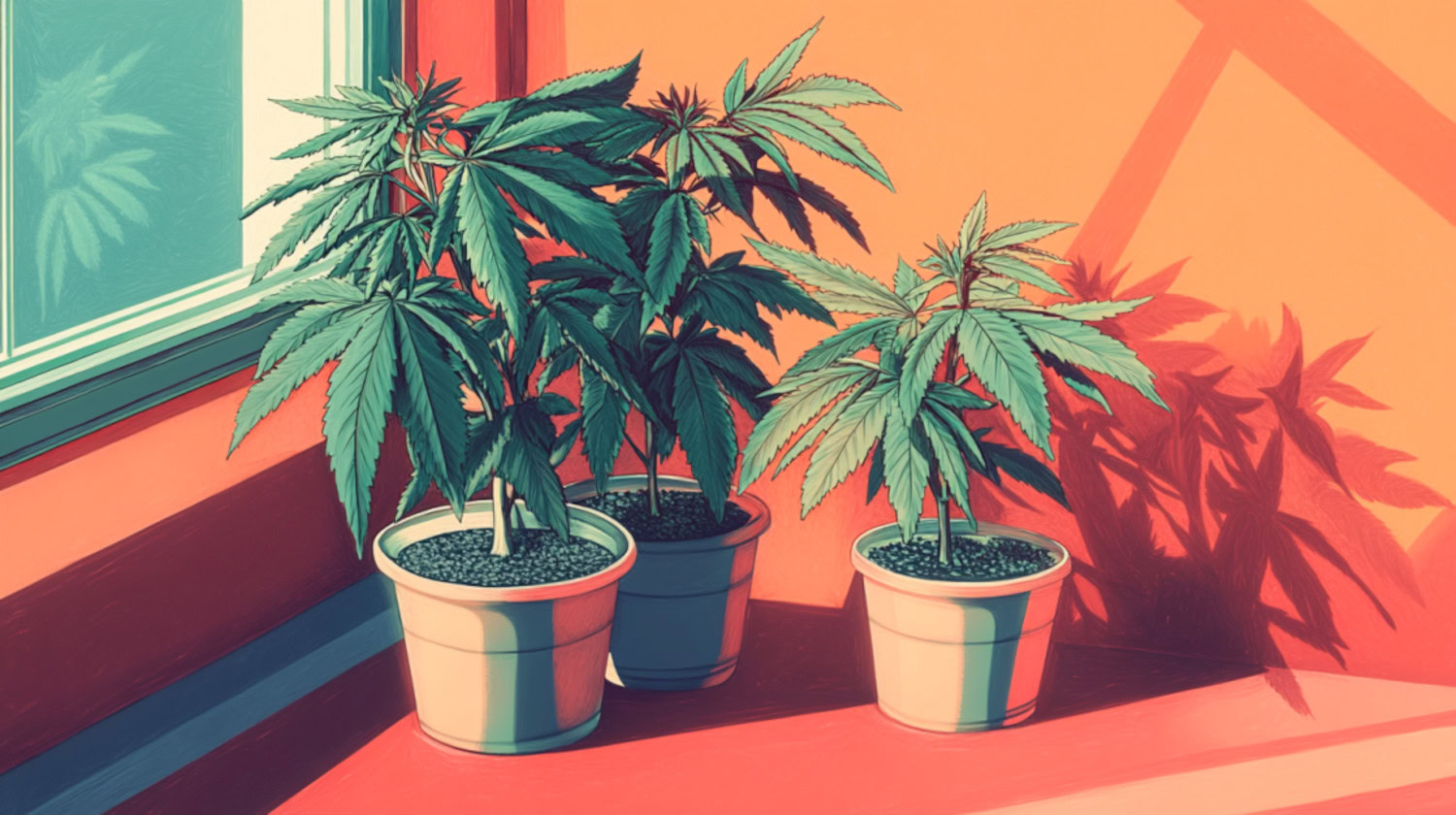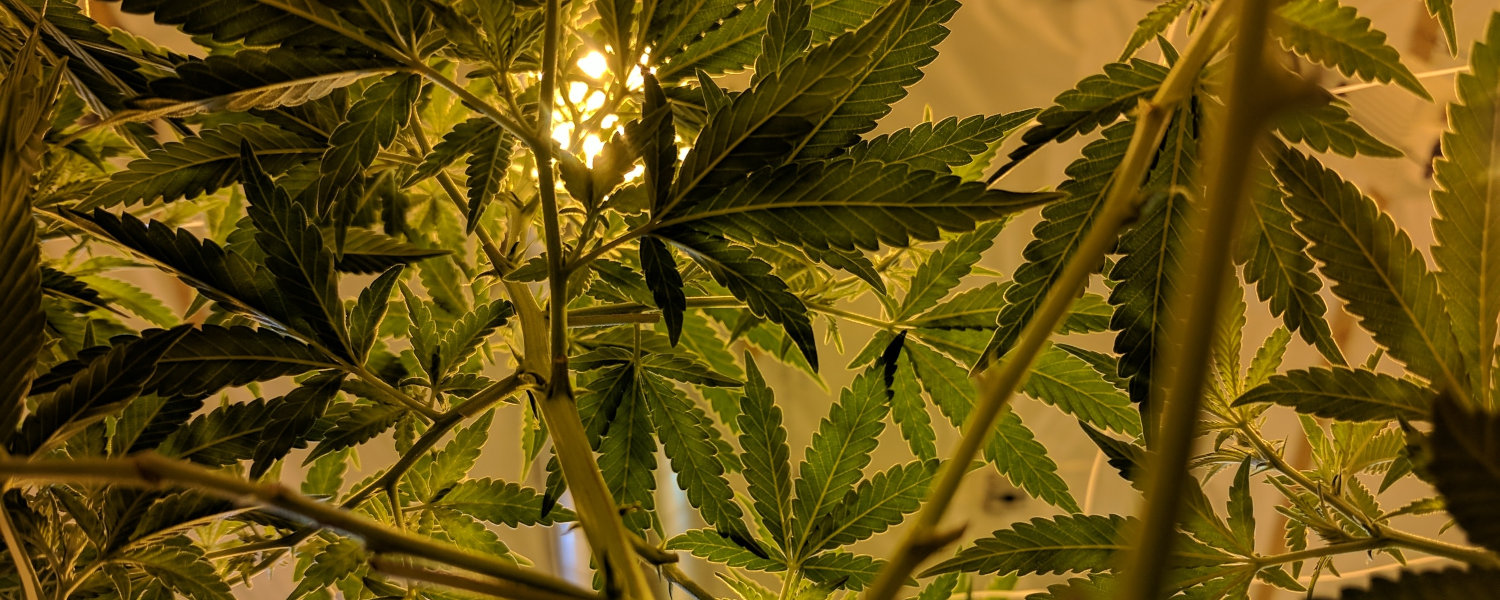In This Article
- Why Grow Massive Plants?
- Strains and Genetics
- Outdoor vs. Indoor Growing
- Nutrition and Soil for Growing 10 Pound Plants
- Soil Quality
- Fertilization
- Watering
- Growing Techniques for Maximum Plant Size
- High-Stress vs. Low-Stress Training
- Light Manipulation Techniques
- Regular Maintenance
- Dealing With Common Problems
- Pest Management
- Disease Prevention
- Nutritional Imbalances
- How Much Weed Does One Plant Yield?
- 1 Pound Plant
- 5-Pound Plants
- 10-Pound Plants
- Is Growing 10 Pound Plants Worth the Effort?
- Effort vs. Reward
- Efficiency and Sustainability
- Personal and Medical Use
- Legal Considerations
- Growing Beyond Expectations
- References
Key Takeaways
- Growing 10 pound plants requires careful selection of the strain as well as controlling the soil and conditions of the plant.
- A combination of techniques like high-stress training, topping, and low-stress training is often required to maximize size and yield.
- Larger plants usually require a lot more work to maintain. Growing multiple smaller plants is usually preferable where possible.
Cannabis cultivation, once a hidden practice, has gained legal acceptance in many states, particularly for medical patients. In a significant number of these states, medical patients have the right to grow their own cannabis, marking a substantial shift in cultural and legal attitudes towards this therapeutic plant. However, it's crucial to recognize that many states still prohibit such cultivation.
Growing your own cannabis offers control over quality, potential cost savings, and potential therapeutic benefits. However, it requires more than just basic gardening skills; it involves understanding the plant's needs and careful environmental management. Factors like genetics, pot size, and growing conditions are crucial for achieving substantial yields.
The goal of growing 10 pound plants, though ambitious, is achievable with the right approach. This guide focuses on essential aspects like strain selection, optimal growing conditions, and advanced cultivation techniques, providing insights for growers aiming to achieve high yields.
Why Grow Massive Plants?
Choosing to grow massive cannabis plants goes beyond the challenge or pursuit of bragging rights; it’s a decision rooted in practicality and strategy. Understanding the physical characteristics of these plants at different sizes can help illustrate this point.
What does a 1 pound plant look like?
Picture a small, compact shrub, unassuming yet efficiently producing its yield. This modest scale is where many home cultivators start. It’s a manageable size for those new to cannabis cultivation, providing a practical introduction to growing.
As you scale up, a 5-pound plant resembles a more robust, medium-sized bush, showcasing a noticeable increase in size and potential output. Growing a plant of this size requires more attention and resources but can yield a significantly larger harvest.
A 10-pound plant, in contrast, stands as a towering, lush giant. Each scale-up is not only a leap in physical size but also in the potential yield and efficiency of the cultivation process. However, it’s important to note that a plant's size and appearance can vary widely based on its genetics, growing conditions, and cultivation techniques.
In many states, the legal framework for home cultivation of cannabis is focused more on the number of plants rather than the quantity of yield. This regulation inadvertently steers growers towards maximizing yield from each plant.
By cultivating fewer but larger plants, growers can stay within legal plant count limits while still harvesting a substantial amount of cannabis. This approach is especially beneficial for medical patients who require consistent, large quantities of cannabis for their therapeutic needs.
The cultivation of a 10-pound cannabis plant offers unique advantages. While these larger plants have the potential for increased production of cannabinoids and terpenes, the key compounds for therapeutic qualities, this potential also depends on the plant’s genetics, health, and environmental conditions. While a larger size might mean more physical space for bud development, quality, and potency are influenced by broader factors than size alone.
Growing larger plants can be a more sustainable and efficient use of resources, especially regarding space utilization. However, these larger plants might demand more water, nutrients, and overall care, which could counterbalance some efficiency aspects. Growing larger plants is a practice that maximizes output per plant, reducing the need for frequent replanting and cultivation cycles.
Strains and Genetics

Selecting the right strains is crucial in the pursuit of growing 10-pound plants. The choice involves more than choosing between indica or sativa; it's about identifying genetic traits conducive to larger yields.
Consider strains renowned for their robust growth and sizable harvests. Strains like Critical Mass, Blue Dream, Amnesia Haze, and Northern Lights are often recognized in cultivation circles for their high-yield potential. These strains have genetic predispositions that support larger plant sizes and denser buds, contributing to heavier harvests.
While the broad labels of indica and sativa provide a basic framework, the focus should be on specific genetic traits. Some strains, known for dense, resinous buds, can offer more substantial yields.1 However, looking at each strain's genetic lineage and characteristics and how they align with your growing environment and goals is key.
When selecting strains, consider the following:
- Climate Compatibility: Choose strains that are suitable for your local climate conditions.
- Space Requirements: Due to their growth patterns, some strains require more space to flourish.
- Flowering Time: Consider how long each strain takes to flower, which can impact the overall yield.
- Personal Preference: Factor in the effects and flavors you prefer, as enjoyment is also a key aspect of cultivation.
Selecting seeds with optimal genetics involves more than just strain choice. Consider the following seed quality indicators:
- Size and Shape: Healthy cannabis seeds are generally plump and round. Smaller, irregularly shaped seeds may indicate poor quality or immaturity.
- Color and Texture: High-quality seeds usually have a dark color, with shades of brown or grey, and may display a tiger-stripe pattern. They should have a smooth, hard outer shell.
- Age and Storage: Fresh seeds stored in a cool, dry place have higher germination rates. Older seeds or those stored in fluctuating conditions may have reduced viability.
Opt for seeds from reputable breeders, ensuring they are known for high yields and robust growth. Align your choice with your specific growing conditions, whether indoor or outdoor and your experience level.
Outdoor vs. Indoor Growing
For those looking to grow 10-pound cannabis plants, whether in a small space or a large facility, understanding the key conditions for both indoor and outdoor cultivation is essential. Each environment offers unique advantages and challenges that can significantly impact the growth potential of your plants.
The allure of outdoor cultivation lies in its natural approach. Cannabis plants benefit from the full spectrum of sunlight, which can lead to robust growth and significant yields. The natural environment also offers a larger growing space, allowing plants to reach their full potential in size. However, outdoor growers must contend with variability in weather, potential pests, and the limitations of the growing season. These factors can impact the consistency and size of the yield.
Indoor cultivation, on the other hand, offers control over the growing environment. Factors like light, temperature, humidity, and CO2 levels can be meticulously managed, creating ideal conditions for growth year-round. This controlled environment can be optimized for growing large plants, albeit with a higher initial investment in equipment and ongoing costs for electricity. However, space is often more limited indoors, which can restrict the size of the plants unless advanced techniques and setups are employed.
Whether growing indoors or outdoors, the key to potentially achieving 10-pound plants lies in understanding and optimizing the specific conditions of your chosen environment.
Indoor Conditions:
- Light Intensity: Use high-quality LED or HPS lights. Adjust their intensity and positioning for even coverage and optimal growth stimulation.
- Controlled Environment: Maintaining optimal temperature, humidity, and CO2 levels.
- Advanced Techniques: Utilizing hydroponics, ScrOG, or SOG methods.
Outdoor Conditions:
- Optimal Sunlight: Direct, unobstructed sunlight is crucial.
- Sufficient Space: Larger pots and ample space for each plant.
- Appropriate Climate: Suitable temperature and humidity, avoiding extreme weather.
Nutrition and Soil for Growing 10 Pound Plants

The foundation of any successful cannabis cultivation, especially when aiming for 10-pound plants, lies in the quality of the soil and the nutrition provided. Soil and fertilizers play a critical role in the growth and health of cannabis plants, influencing everything from root development to bud size and potency.
Soil Quality
- Optimal Soil Composition: Aim for a soil mix that perfectly balances aeration, drainage, and nutrient retention. A blend of loam, perlite, vermiculite, and organic compost creates an ideal growth medium.
- pH Balance: Maintain a soil pH level between 6.0 and 7.0 to optimize nutrient absorption. Slightly acidic to neutral pH levels ensure the availability of essential nutrients.
- Microbial Life: Incorporate compost tea or mycorrhizal inoculants to enhance microbial life in the soil, promoting healthier root systems and better nutrient uptake.
Fertilization
- Nutrient Requirements: In the vegetative stage, prioritize nitrogen-rich fertilizers for robust foliage and stem growth. During flowering, shift to phosphorus and potassium-heavy fertilizers to support bud development.
- Organic vs. Synthetic: Organic fertilizers, like fish emulsion, bat guano, or worm castings, offer gradual nutrient release and enrich soil health. In contrast, synthetic fertilizers provide fast nutrient availability but can lead to salt buildup and nutrient lockout if not managed carefully.
- Application Strategy: Apply fertilizers based on the plant's life cycle stages, being careful to avoid over-fertilization, which can lead to nutrient burn.
Watering
Balance your watering schedule to maintain moist but not waterlogged soil conditions. Over-watering can lead to root rot, while under-watering stresses the plant, affecting nutrient uptake and plant growth.
Growing Techniques for Maximum Plant Size
To cultivate cannabis plants that potentially weigh as much as 10 pounds, growers must leverage a combination of advanced growing techniques. These methods enhance the plant's structural development and maximize its exposure to essential growth factors like light and nutrients.
High-Stress vs. Low-Stress Training
Cannabis plants respond to stress in various ways. Growers can use this to their advantage through techniques known as high-stress training (HST) and low-stress training (LST).
- High-Stress Training: HST methods, like topping (removing the top part of the plant to encourage the growth of multiple colas) or supercropping (intentionally damaging the plant to make it grow denser), can dramatically increase yields. However, they require precise execution and timing, as excessive stress can harm the plant.
- Low-Stress Training: LST, on the other hand, involves gently bending and tying down branches to expose more of the plant to light, promoting even growth and larger yields without the risk of severe stress. Techniques like Sea of Green (SOG) or Screen of Green (ScrOG) are popular LST methods.
Often, a combination of these techniques yields the best results. Starting with LST to establish a robust and well-structured plant and then applying HST methods at the appropriate growth stages can lead to substantial increases in size and yield.
Light Manipulation Techniques
- Indoor Light Management: Manipulating light cycles is a powerful tool for indoor cultivation. Extending the vegetative phase can allow more time for the plant to grow, while light deprivation techniques can be used to induce flowering at the optimal time.
- Maximizing Exposure: Ensuring even light distribution across the canopy through training and plant arrangement can significantly influence plant size and bud development.
Regular Maintenance
Regular pruning and maintenance are also essential. Removing dead or non-productive parts of the plant ensures that all energy is directed toward the growth of healthy buds. The best time for heavy pruning is during the vegetative stage, while light pruning can be done in the early flowering phase.
Defoliation involves removing some of the larger fan leaves that might block light from reaching lower bud sites. This increases light penetration and air circulation around the buds, promoting better growth and reducing the risk of mold or mildew.
Inspecting your plants regularly for signs of pests and diseases is vital. Early detection and treatment can prevent widespread damage. Look for discoloration, spots on leaves, and any visible insects or webs.
Dealing With Common Problems

Growing cannabis comes with its share of challenges. Common problems like pests, diseases, and nutritional imbalances can hinder growth and reduce yield if not adequately managed. Here are some strategies to deal with these issues while adhering to organic farming practices, as no one wants to consume cannabis treated with harmful chemicals.
Pest Management
Regular inspections for early signs of pests can prevent infestations from becoming unmanageable. Identifying pests early on allows for more effective and less invasive treatment options.
Use organic methods like neem oil, a natural pesticide, or introduce beneficial insects like ladybugs or lacewings to control pest populations naturally. Companion planting with certain herbs and flowers can also deter pests.
Disease Prevention
Diseases, often caused by fungi or bacteria, can be devastating. Prevention is key. Ensure good air circulation, avoid overwatering, and maintain cleanliness around the growing area. Should a problem arise, organic fungicides and bactericides are common remedies often used to address the issue without compromising the plant's integrity.
Nutritional Imbalances
Cannabis plants showing signs of nutritional deficiencies or excesses require immediate attention. Yellowing leaves, stunted growth, or leaf burn can indicate something is amiss.
For instance, yellowing leaves might indicate a nitrogen deficiency, a common issue during the vegetative stage. On the other hand, symptoms like slow growth and curling leaf tips could signal a calcium deficiency, which can be critical for cell wall development and overall plant health.
Adjusting the feeding schedule or composition of nutrients while ensuring the soil's pH is balanced can often rectify these issues. For example, amending the soil with calcium-rich supplements could be a solution for calcium deficiency.
How Much Weed Does One Plant Yield?
One of the most intriguing questions for any cannabis grower is the potential yield of their plants. The answer varies widely depending on several factors, including the strain, growing conditions, and cultivation techniques. However, understanding the yield potential of 1-pound, 5-pound, and 10-pound plants can provide valuable insights for growers aiming to maximize their output.
1 Pound Plant
A plant yielding 1 pound is considered a successful outcome for many home growers. Achieving this requires good genetics, proper nutrition, and careful environmental management. Such a plant can produce enough cannabis to sustain a personal supply for a considerable time.
5-Pound Plants
A 5-pound plant is a more ambitious goal, often requiring more space, better light exposure, and advanced growing techniques. This yield is typically seen in well-maintained outdoor plants or large-scale indoor setups with optimized conditions.
10-Pound Plants
Growing a 10-pound plant is a remarkable achievement, often the result of expert cultivation practices. It requires meticulous attention to detail, mastery of growing techniques, and often a favorable outdoor environment with plenty of space and sunlight. Such a yield is not just about quantity; it also speaks to the quality and health of the plant throughout its growth cycle.
It's important to note that while achieving high yields is an exciting prospect, the focus should always be on the health and quality of the plants. Larger yields are often accompanied by a greater need for maintenance and care, and the risks of pests and diseases can also increase.
Is Growing 10 Pound Plants Worth the Effort?

Growing a 10-pound cannabis plant is a demanding task, filled with both challenges and rewards. But is it worth the effort? This question requires growers to consider various factors, including their objectives, resources, and the commitment required to achieve such a goal.
Effort vs. Reward
Growing a plant of this magnitude requires significant investment in terms of time, effort, and resources. For some, the challenge and the potential for a large yield are highly motivating factors. However, for others, especially those with limited space, time, or experience, aiming for smaller, more manageable plants might be more practical and rewarding.
Efficiency and Sustainability
While growing massive plants can be seen as an efficient use of plant count limits, it also requires a deep knowledge of cannabis cultivation. Large plants demand more in terms of soil, water, nutrition, and maintenance. The grower must weigh whether the increase in yield justifies the increased input and potential risk of pest and disease issues.
Personal and Medical Use
For medical users growing for personal use, the decision often hinges on their specific needs. A larger plant might provide a necessary and cost-effective supply of medicinal cannabis. Recreational growers, meanwhile, might find the process of growing a giant plant a fascinating and rewarding hobby.
Legal Considerations
It's also important to consider the legal implications. Growers must always operate within the legal boundaries of their region, which often includes limits on the number of plants but not their size.
Growing Beyond Expectations
Cannabis cultivation is a deeply rewarding experience that blends the art of gardening with the science of botany. Whether you aim for the towering heights of a 10-pound plant or the modest yet satisfying yields of smaller plants, the adventure brings its own set of joys and learning.
As you nurture your plants, you'll not only cultivate cannabis but also grow in knowledge and experience. Every step in this journey is an opportunity to connect with nature, understand the nuances of this remarkable plant, and enjoy the fruits of your labor.
References
- McPartland JM, Small E. A classification of endangered high-THC cannabis (Cannabis sativa subsp. indica) domesticates and their wild relatives. PhytoKeys. 2020;144:81-112. doi:https://doi.org/10.3897/phytokeys.144.46700 ↩︎
The information in this article and any included images or charts are for educational purposes only. This information is neither a substitute for, nor does it replace, professional legal advice or medical advice, diagnosis, or treatment. If you have any concerns or questions about laws, regulations, or your health, you should always consult with an attorney, physician or other licensed professional.




